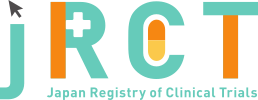臨床研究等提出・公開システム
|
Jan. 28, 2021 |
|
|
May. 31, 2025 |
|
|
jRCT1031200329 |
Open-ravel randomized control trial to evaluate the efficacy of biologics for ulcerative colitis with treatment-refractoriness |
|
UC Bio Study |
|
Feb. 05, 2024 |
|
105 |
|
The baseline characteristics for the full analysis set (FAS) population were as follows. [Infliximab treatment group] n = 33 Sex, male 24 (72.7%) / female 9 (27.3%) Age, 38.9 +- 12.5 years (mean +- SD) duration of disease, 2.9 years (median) [Ustekinumab treatment group] n = 30 Sex, male 17 (56.7%) / female 13 (43.3%) Age, 45.2 +- 18.1 years (mean +- SD) duration of disease, 6.0 years (median) [Vedolizumab treatment group] n = 34 Sex, male 20 (58.8%) / female 14 (41.2%) Age, 52.0 +- 18.6 years (mean +- SD) duration of disease, 2.6 years (median) |
|
One-hundred seven subjects were enrolled and randomized on EDC (Electronic Data Capture) between May 2021 and June 2023, but the actual number of participants, excluding 2 erroneous enrollments, were 105(35 subjects were to the infliximab group, 34 to the ustekinumab group, and 36 to the vedolizumab group. A total of 104 subjects, 34 in the infliximab group, 34 in the ustekinumab group, and 36 in the vedolizumab group started treatment with the study drug. There were 88 subjects who completed 12 weeks (28 in the infliximab group, 30 in the ustekinumab group, and 30 in the vedolizumab group), 66 subjects completed 26 weeks (17 in the infliximab group, 28 in the ustekinumab group, and 21 in the vedolizumab group). The safety population included 104 subjects, 34 in the infliximab group, 34 in the ustekinumab group, and 36 in the vedolizumab group, and the FAS population included 97 subjects, 33 in the infliximab group, 30 in the ustekinumab group, and 34 in the vedolizumab group. |
|
In this study, adverse events were reported in 11/34 subjects (32.4%) in the infliximab group, 13/36 subjects (36.1%) in the vedolizumab group, and 3/34 subjects (8.8%) in the ustekinumab group. In addition, adverse drug reactions were reported in 5/34 subjects (14.7%) in the infliximab group, 6/36 subjects (16.7%) in the vedolizumab group, and 2/34 subjects (5.9%) in the ustekinumab group. Serious adverse events showed in 1/34 subject (2.9%) in the infliximab group and 2/36 subjects (5.6%) in the vedolizumab group, and serious adverse drug reactions showed in 1 subject each in the infliximab group and vedolizumab group. No deaths were reported during the study. |
|
The results in the FAS population (97 subjects) were as follows. The primary efficacy endpoint, clinical remission rates at week 12, were 36.4 (95% confidence interval [95%CI], 20.4 to 54.9)% in the infliximab group, 43.3 (95%CI, 25.5 to 62.6)% in the ustekinumab group, 32.4 (95%CI, 17.4 to 50.5)% in the vedolizumab group, and the remission rate was higher in the ustekinumab group than in the other treatment groups. But no statistically significant difference in remission rates was found between treatment groups (infliximab vs. ustekinumab P = 0.5726, infliximab vs. vedolizumab P = 0.7297, ustekinumab vs. vedolizumab P = 0.3665: Wald test.). Therefore, we didn't confirm the clear differences between treatment groups about the clinical remission rate at week 12. Because the superiority of infliximab over ustekinumab and of infliximab over vedolizumab in the primary endpoint was rejected, we didn't perform statistical tests for the secondary endpoints. Although the ustekinumab group outperformed the other treatment groups in some areas, such as the efficacy rate at week 12 and the endoscopic remission rate at week 12, overall, there were no major differences in the results between the treatment groups. |
|
Although the clinical remission rate at week 12, the primary endpoint, was higher in the ustekinumab group than those of the other treatment groups, comparison of the groups showed no statistically significant differences between infliximab, ustekinumab, and vedolizumab. Therefore, in the efficacy evaluation, the inferiority of ustekinumab and vedolizumab to infliximab, the anti-TNF-alpha drug was not verified. In safety, no new adverse events or adverse drug reactions requiring confirmation were reported. |
|
May. 31, 2025 |
|
No |
|
N/A |
|
https://jrct.mhlw.go.jp/latest-detail/jRCT1031200329 |
Naganuma Makoto |
||
Kansai Medical University Hospital |
||
2-3-1, Shinmachi, Hirakata, Osaka |
||
+81-72-804-2521 |
||
naganuma@hirakata.kmu.ac.jp |
||
Naganuma Makoto |
||
Kansai Medical University Hospital |
||
2-3-1, Shinmachi, Hirakata, Osaka |
||
+81-72-804-2521 |
||
naganuma@hirakata.kmu.ac.jp |
Complete |
Jan. 28, 2021 |
||
| May. 18, 2021 | ||
| 231 | ||
Interventional |
||
randomized controlled trial |
||
open(masking not used) |
||
active control |
||
parallel assignment |
||
treatment purpose |
||
1) Patients who meet the criteria of the ulcerative colitis diagnostic criteria (revised in 2018) of the Ministry of Health, Labor and Welfare Specified Disease or Intractable Inflammatory Intestinal Disorders Research Group |
||
1) Patients classified as fulminant in the clinical severity classification |
||
| 16age old over | ||
| No limit | ||
Both |
||
Ulcerative colitis |
||
Infliximab:Infliximab (5 mg / kg / body weight) is infused intravenously at 0, 2, 6, 14, and 22 weeks. |
||
Biologics |
||
D003093 |
||
Clinical remission rate at Week 12 |
||
1 Clinical response rate at Week 12 |
||
| Japan Agency for Medical Research and Development | |
| Not applicable |
| Division of Gastroenterology and Hepatology, Kansai Medical University | |
| Not applicable |
| Tokyo Medical and Dental University Certified Clinical Research Review Board | |
| 1-5-45, Yushima, Bunkyo-ku, Tokyo | |
+81-3-5803-4575 |
|
| mkan-rinsho.adm@cmn.tmd.ac.jp | |
| Approval | |
Dec. 18, 2020 |
none |
